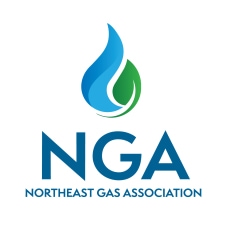About LNG
Liquefied natural gas (LNG) is natural gas (primarily methane) that has been liquefied by reducing its temperature to minus 260 degrees Fahrenheit. It can be compressed, stored and
transported over long distances by ship; and then stored on land in specially-designed storage facilities. The liquefied gas can then be reheated, converted to vapor, and injected into a
pipeline system, for distribution throughout a gas system. It can also be transported to local utility storage tanks via truck.
LNG has traditionally been used for supplemental supplies, particularly for winter peak periods. It is also important in particular areas (like parts of New England) to help maintain system
pressures at different points of the regional natural gas system. It is a fuel with multiple applications, from powering electric generation plants to fueling heavy-duty trucks and water
ferries, among other applications.
LNG can help meet demand for natural gas, and provide supply flexibility to the natural gas and energy marketplace.
Use of LNG in the Northeast
LNG remains an important fuel for New England - providing about 28% of design day supply in the winter for local gas utilities.
There is no underground storage located in New England (geologic unsuitability.) LNG is thus an important part of the region's supply and deliverability network.
There are liquefaction and satellite storage tanks in localities in the region that are owned and operated by the local distribution companies (LDCs).
In 2022, according to NGA, the LNG storage capacity in New England among the local distribution companies (LDCs) was 16 Bcf (which does not include the storage at the Everett LNG terminal).
Vaporization capacity for daily sendout by New England gas LDCs was approximately 1.4 Bcf/day; and liquefaction capability by the LDCs was 43,500 MMBtu/day. Liquefaction capability will
increase a bit in 2023 when National Grid completes its project to add liquefaction at its Providence, RI facility.
LNG is also part of the utility supply portfolios in New Jersey, downstate New York and Pennsylvania.
LNG is utilized by several LDCs in New Jersey, with total state storage capacity of about 4 Bcf.
LNG in New York is obtained by liquefaction of pipeline gas. Two LDCs maintain LNG peak-shaving plants. The facilities provide service area system reliability as well as assist in meeting
peak day requirements. These facilities have storage capacity of approximately 3.2 Bcf, liquefaction capability of 16,800 Mcf/day, and a vaporization rate of approximately 26,100 Mcf/hr.
One utility in southeastern Pennsylvania uses LNG for injection into its system, with total storage capacity of about 4.25 Bcf at two plants. It receives LNG through both liquefaction and trucking. Another PA gas utility operates an LNG liquefaction plant with storage capacity of 1.25 Bcf; through a subsidiary, it provides delivery of LNG by truck to serve Mid-Atlantic and New England markets
Imports in the region (and in the U.S.) have been on the decline in recent years as U.S. domestic natural gas production has been on the increase. With its more limited pipeline infrastructure, the Northeast and especially New England, however, remain key markets for LNG. The import terminals near Boston and in New Brunswick, Canada are well-positioned to respond to market conditions if contract arrangements are in place.
Recent LNG Imports into New England
Everett LNG in 2022 imported 20.7 Bcf (source: U.S. Department of Energy, Office of Natural Gas Import and Export Activities).
The offshore Northeast Gateway facility imported 2.8 Bcf in 2022.
New England also receives supplies from the Saint John LNG facility in Saint John, New Brunswick, Canada (the facility was previously known as Canaport). The facility is located about 60
miles from the Maine border. The facility was jointly developed by Repsol and Irving Oil and became operational in 2009; since late 2021 it has been fully owned by Repsol. In 2022 it imported
10.8 Bcf (source: Canada Energy Regulator).
Import Facilities in New England
There are three import facilities in New England: the Everett LNG facility in Everett, MA; the Northeast Gateway facility offshore Cape Ann, MA; and the Neptune facility offshore Cape Ann, MA. The first two are operating; the operating license of the third is currently suspended per its own request.
Everett LNG, formerly known as Distrigas, is a subsidiary of Constellation. Its Everett, MA facility has been in operation since 1971. It has storage of 3.4 billion cubic feet (Bcf). The terminal's maximum installed vaporization capacity is about one billion cubic feet per day; on a sustainable basis, the vaporization capacity is approximately 700 million cubic feet per day. It also has sendout capability of 100,000 MMBtu/day by truck, which supports local storage refills for local gas utilities throughout the region. The terminal is directly connected to the interstate pipeline network and to National Grid's local distribution system in the Boston area. In 2003, a nearby power plant with two units, with total nameplate capacity of about 1,500 megawatts, entered service, fueled by LNG from the terminal. Everett has received over 1,200 cargoes.
The Northeast Gateway facility is owned and operated by Excelerate Energy. The facility began commercial operations in May 2008. Operating approximately 18 miles east of Boston in
Massachusetts Bay, the offshore LNG facility is capable of injecting vaporized natural gas into the existing offshore HubLine natural gas pipeline system operated by Enbridge. The offshore
facility has varied in its levels of imports over the years. It imported several cargoes from 2008 to 2010, but no cargoes from 2011 to 2014. It brought volumes in for deliveries into the New
England market in early 2015 and early 2016, during the high-demand peak winter months; but then no cargoes in 2017 or 2018. It provided volumes in early 2019 during several high demand cold
weather days. In 2020 and 2021, it brought no cargoes in, but it provided volumes in early 2022 during a period of cold weather in the region, with high spot natural gas and power market
prices.
The Neptune LNG facility was developed in 2010 by ENGIE, which also operated Distrigas at that time. The facility is located approximately 10 miles off the coast of Gloucester, MA. The Neptune port consists of a buoy system where LNG vessels could moor and discharge natural gas by using onboard vaporization equipment. It is capable of injecting about 0.4 Bcf per day of gas into the pipeline system from a special regasification system on-board its delivery vessels. However, it has not been active since its start-up. Several years ago, the U.S. Maritime Administration (MARAD), part of the U.S. Department of Transportation, approved the request of Neptune LNG LLC (Neptune) for a suspension of port operations at the Neptune Deepwater Port (Neptune Port) by amending the Neptune Deepwater Port License (License). In November 2021, MARAD received a written request from Neptune for authorization to extend the period of suspended operations at the Neptune Port. In the request, Neptune indicated that conditions within the Northeast region's natural gas market continue to impact the Neptune Port's ability to import liquefied natural gas (LNG). As a result, the Neptune Port has remained inactive and will likely remain inactive for the foreseeable future. For these reasons, Neptune requested MARAD's authorization to formally suspend port operations for an additional period of three years. MARAD approved the request. The new suspension period became effective June 22, 2022, and will extend until June 26, 2025.
E. Canada Import Facility
In June 2009, the Canaport LNG terminal in Saint John, New Brunswick, Canada began operation. It was developed by Repsol and Irving Oil. It has 3 storage tanks; each tank can hold 3.3 Bcf. It is capable of moving on average over 700 million cubic feet per day into the Brunswick Pipeline and then the Maritimes & Northeast Pipeline for delivery into Maine and New England. Its markets are in the Maritimes, New England and the Northeast. Since its inception, it has introduced over 450 Bcf into the market. In November 2021, Repsol acquired 100% of the assets and the facility was renamed from Canaport to Saint John LNG.
U.S. Exports of LNG
With the rise in U.S. domestic production in recent years, and with geopolitical changes impacting global market demand, there continues to be interest in developing LNG export facilities in
the U.S. Seven export terminals are currently in operation (the most recent facility went into operation in April 2022 in Louisiana).
The U.S. Department of Energy maintains a list of export facility project applications; the list is posted online (http://energy.gov/fe/downloads/summary-lng-export-applications-lower-48-states).
In 2022, the U.S. exported 3,861 Bcf (or 3.9 Tcf) of LNG by vessel (compared to imports of 23.5 Bcf). U.S. export volumes go to areas such as Asia, South America, and Europe. U.S. LNG exports to Europe increased in 2022 after Russia's invasion of Ukraine and the cessation of Russia's natural gas exports to Europe.
Most of the U.S. export facilities are located in the Gulf Coast region. The U.S. production areas seeing the most market demand for LNG exports are in the Southwest (e.g., Texas). In March 2022, the U.S. EIA noted: "Natural gas from the Appalachia Basin also reaches export markets; however, we project that the majority of new production from this region will be directed toward domestic markets because access from Appalachia to export terminals is constrained by pipeline infrastructure. As a result, the region's relatively low production costs are predominately driving the growth in Appalachia's natural gas production."
U.S. LNG exports have grown substantially in recent years and are on track to grow further during this current decade, in response to shifting global energy market dynamics. In March 2022, the U.S. government and the European Union announced an agreement to help Europe reduce its dependence on Russian energy in the wake of Russia's invasion of Ukraine. Among the actions, the U.S. said it "will work with international partners and strive to ensure additional LNG volumes for the EU market of at least 15 bcm in 2022, with expected increases going forward."
In March 2023, the U.S. EIA reported that U.S. LNG exports are expected to continue to grow over the next 2 years. EIA stated: "we forecast that U.S. LNG exports will average 12.1 billion cubic feet per day (Bcf/d) in 2023, a 14% (1.5 Bcf/d) increase compared with last year. We expect LNG exports to increase by an additional 5% (0.7 Bcf/d) next year [2024]. We forecast U.S. LNG exports to rise because of high global demand as LNG will continue to displace pipeline natural gas exports from Russia to Europe."
Portable LNG (and CNG)
Another development is the use of portable or mobile LNG and CNG (compressed natural gas) to bring natural gas to industries and businesses not located near a pipeline system or within a distribution service area. Some areas and businesses in the Northeast region that are not connected to local gas systems are opting for gas (LNG or CNG) delivered by truck to meet energy needs. The gas is transported via a trailer that also can serve to offload the gas into the facility. This is currently being utilized to serve paper mills, farms and other entities. It is also being considered to assist local gas utilities in accessing additional supplies in areas of highly constrained pipeline delivery.
LNG for Transportation
The value of natural gas is also leading some companies with vehicle fleets to consider CNG and also LNG as a transport fuel. LNG is of greatest interest for heavy-duty trucks that travel
long distances.
A 2012 study by ANGA on LNG as a transportation fuel notes: "LNG has higher energy density than CNG and thus offers significant potential in NGV market segments where long vehicle ranges are
required. Because LNG must be stored at extremely low temperatures, the tanks required to maintain these temperatures on vehicles are large. As such, LNG is most appropriate for heavy-duty
vehicles, which can accommodate the volume needed for LNG storage."
LNG is also suitable for fueling of marine transport-such as water ferries-and rail.
LNG Terminals in Northeastern North America
A map of the operating facilities in the Northeast region is shown here.




